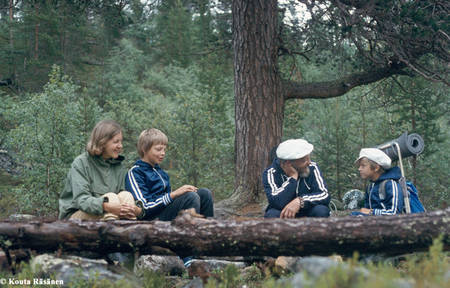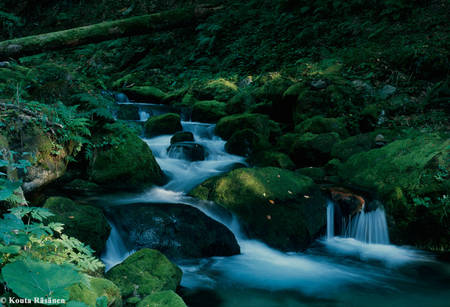Why baumzaehlen.de?
I have loved nature from childhood. From the age of eleven years, I made an annual wilderness hike with my family in Finnish Lapland (Image 1). Nowadays, I particularly enjoy roaming in primeval forest and studying the tree species. When I haven´t time for this, reading about forests and trees and looking at photos of primeval forest are good alternatives. But such photos are difficult to find, especially since I would like to know the photographed tree species. In addition, forest photo books often concentrate on subjects other than the forest: waterfalls, creeks (see Image 2), flowers, mosses, mountains... On the other hand, there are plenty of detailed, useful photos of tree species - even rare ones - in the Internet, but almost always taken in gardens.
As my contribution to the Internet´s primeval forest photo gallery, I introduce on this site a small collection of forests in a relatively natural state. There are also photos of individual trees but they have all been taken in “primeval forest” (for definitions of primeval forest, see below). Some of the photographed locations can only be reached by extended off-trail hikes; some are located near trails or even roads. Some parts of the world are strongly over-represented, at least for now: western and northern North America and southeast Australia for large wildernesses, tall forests and easiness of travel, and Europe because I live there. I have chosen to write “semi-scientifically” (some might consider it “pseudo-scientific”) - somewhere between photo books and scientific text. In the photos, I have aimed at naturalness by mainly using a standard lens and only seldom filters, and by editing sparingly. I intend to extend the selection of forests covered in the future.
Why trees in the leading role?
The objective answer is: trees form forest, there is no forest without trees; and the subjective one: because trees are my primary interest. I got particularly enthusiastic about trees when I visited Vancouver Island´s mighty coniferous forests for the first time; especially the Sitka spruces (
![]() Picea sitchensis
) in
Picea sitchensis
) in
![]() Carmanah Walbran Provincial Park
created a great impression.
Carmanah Walbran Provincial Park
created a great impression.
The distinction between trees and shrubs is often arbitrary. The species mentioned on this site are mainly true trees but I have also included a few species which are rather tall shrubs, and a few species which are shrubs in the area in question but may in other environments reach tree stature.
What does baumzaehlen mean?
When I first met a friend of mine, Christoph, he considered my tree hobby funny and said that Kouta goes ”counting trees” (Bäume zählen). When we began to construct this site together, it was clear from the beginning that this would be its name.
What is primeval forest?
In the European terminology, “primeval” or “virgin” forest is usually defined as having a natural or original forest structure, with an absence of anthropogenic influences, past or present
1 2
. Some definitions also require the last successional stage, “climax”
3
. The North American term “old-growth forest” is a bit more complicated. Much of the confusion over its definition may stem from its origins when old growth was a word associated with temperate rainforests of western North America, which are dominated by big and long-lived trees
4
. Sometimes "old-growth forest" is defined approximately like “primeval forest” (see above)
5
, but “old growth” implies old trees and often old-growth forest is assumed to be composed of old trees, besides being natural
6 7
. Old-growth forest is also defined as being only a successional stage, without assuming absence of anthropogenic disturbances
8
. In North America and also in Australia, old-growth forest is sometimes defined as forest that has not been, or has been only minimally, affected by exploitative activities by European colonisers - whether or not the trees in it now are old; the impact of native inhabitants is accepted as part of the natural order
6 9
. This latter definition makes defining naturalness easier. However, does it also place non-Europeans between animals and man, although impacts by Native Americans and Australian Aborigines were definitely small in comparison with those of the Europeans colonisers? Further, Native Americans cleared extensive forest areas on floodplains and lower river terraces and there were large fields near Native American settlements
10
. They also set fires, hunted, harvested, and otherwise affected local areas to various degrees
11
.
Of course, there are no forests that completely lack anthropogenic influences. Even the most remote wilderness is affected at least by atmospheric transport of pollutants. The term “primeval forest” has also suffered some inflation: especially in countries where no – or very little – undisturbed forest is left “primeval forest” may be used as a synonym for “protected forest” even if it has been managed forest a few decades earlier. In German literature all the tropical rainforests are often considered to be primeval (Urwälder), but parts of the Amazon rainforest had a fairly dense human population in pre-Columbian times
12
and even the most remote areas of New Guinea are settled
13
. Of forest regions, temperate forests are the most heavily fragmented and disturbed, while boreal forests include the largest amount of relatively undisturbed forest (predominantly in Russia and Canada)
14
.
On this site, “primeval forest” is considered to be forest in a relatively natural condition, showing only relatively minor anthropogenic influence. Such forest may be in an early successional stage, too, if the disturbance which started the succession was natural. In Central Europe, where very little old forest remains, I have accepted some parks that are primeval forest only in a very wide sense, at most, notably
![]() Draved Skov
,
Draved Skov
,
![]() Hainich National Park
and
Hainich National Park
and
![]() Eisgraben Nature Reserve
.
Eisgraben Nature Reserve
.
What is the future of primeval forests?
Unprotected primeval forests continue to be destroyed by man, but even protected forests are not safe. The global warming is an often forgotten threat. As climate changes, local climate is not anymore suitable for trees (and other plants) adapted to the former climate. The response by boreal forests, for example, may involve the extinction of slow-growing species and the selection of early-successional trees and shrubs. Early-successional species are light-demanding, so this scenario suggests an open landscape of scattered trees forming woodlands or savannas, and the absence of the dense forests we know today.
15
Another man-induced threat is invasive alien species. They have caused drastic changes in the receiving biota. Firstly, they decrease the distinctiveness of local floras and faunas; secondly, they break down the geographic isolation of separate biotic regions that maintains global biodiversity. Species invasions are considered as a serious threat to global biodiversity, second only to vegetation clearing.
16
As primeval forests diminish, they are increasingly difficult to reach. In addition, many countries have declared their primeval forest remnants as scientific reserves either closed to the public or with limited access for guided groups only. Consequently, opportunities for wandering in primeval forest are becoming increasingly rare.
Acknowledgements
My thanks to Don Welsh, who checked my English and made useful suggestions about the contents. My thanks to my wife Anna, who allowed me to make my numerous trips.
References
1 Mayer, H. & Brünig, E. (1980): Waldbauliche Terminologie. IUFRO-Gruppe Ökosysteme, Institut für Waldbau, Universität für Bodenkultur, Wien.
2 Leibundgut, H. (1982): Europäische Urwälder der Bergstufe. Haupt. Bern.
3 Gratzer, G. & Splechtna, B. (2014): Wissenschaftlicher Rundgang Rothwald.
4
Hilbert, J. & Wiensczyk, A. (2007):
![]() Old-growth definitions and management: A literature review.
BC Journal of Ecosystems and Management
8
(1):15–31.
Old-growth definitions and management: A literature review.
BC Journal of Ecosystems and Management
8
(1):15–31.
5 Dudley, N. (1992): Forests in trouble: A review of the status of temperate forests worldwide. WWF.
6 Leverett, R. (1996): Definitions and History. In Davis, M. B. (ed.): Eastern Old-Growth Forests. Prospects for Rediscovery and Recovery . Island Press.
7 Hunter, M. (1989): What constitutes an old-growth stand? Journal of Forestry 87 : 33-5.
8 Oliver, C. D. & Larson B. C. (1996): Forest Stand Dynamics. Wiley.
9 Resource Assessment Commission (1991): Forest and timber inquiry. Draft Report, Vol. 1. Australian Government Publishing Service.
10 White, P. S. & White, R. D. (1996): Old-Growth Oak and Oak-Hickory Forests. In Davis, M. B. (ed.): Eastern Old-Growth Forests. Prospects for Rediscovery and Recovery . Island Press.
11 Runkle, J. R. (1996): Central Mesophytic Forests. In Davis, M. B. (ed.): Eastern Old-Growth Forests. Prospects for Rediscovery and Recovery . Island Press.
12
Bush, M., Correa, A. & Mayle, F.: Legacies of Pre-Columbian disturbance on Amazonia.
13 Flannery, T. (1998): Throwim Way Leg: Tree-kangaroos, Possums, and Penis Gordes. On the Track of Unknown in Wildest New Guinea. Atlantic Monthly Press.
14 Bryant, D., Nielsen, D. & Tangley, L. (1997): The Last Frontier Forests: Ecosystems and Economies on the Edge. World Resources Institute.
15 Solomon, A. M. (1992): The nature and distribution of past, present and future boreal forests: lessons for a research and modelling agenda. In Shugart, H. H., Leemans, R. & Bonan, G. B. (eds.): A System Analysis of the Global Boreal Forest . Cambridge.
16 Lövei, G. L. (1997): Global change through invasion. Nature 388 , 627-628 .


